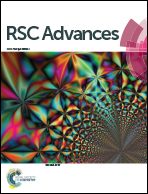Sensitive and fast fluorescence-based indirect sensing of TATP†
Abstract
Sensing of TATP vapours via the decomposition product, hydrogen peroxide, was achieved using a fluorescence “turn-on” mechanism through conversion of boronate esters to phenoxides under basic conditions in solid-state films. High sensitivity was achieved with two new fluorenylboronate esters comprising either 2,4-difluorophenyl or 4-(trifluoromethyl)phenyl substituents. The key to the sensitivity was the fact that the phenoxide anion products from the hydrogen peroxide oxidation absorbed at longer wavelengths than the starting boronate esters. Selective excitation of the phenoxide anions avoided the background fluorescence from the corresponding boronate esters. The use of the electron withdrawing substituents also led to greater photostability. The derivative containing the 4-(trifluoromethyl)phenyl moiety was found to give the most stable phenoxide, and demonstrated fast fluorescence “turn-on” kinetics with a lower limit of detection of ≈2.5 ppb in 60 s.



 Please wait while we load your content...
Please wait while we load your content...